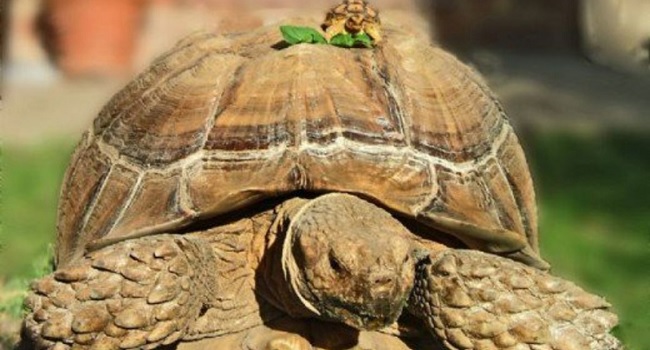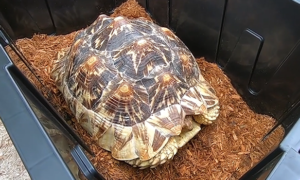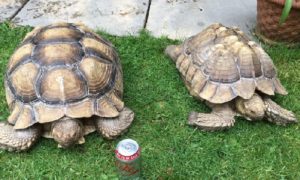Sulcatas are a long-lived animal, growing in batches until the time they stop growing. However, but that point, they’re rather large. They are the third largest tortoise species in the world, averaging about 80-200 pounds and 2.5-3 feet wide. Sulcata tortoises grow at their own pace, however it is important to check your sulcata’s growth is steady.
Sulcata Tortoise Growth Rate
There is not a standard growth pattern for every sulcata. Housing, diet and genetics can truly factor into how fast or slow a baby sulcata will grow. Within the first year a sulcata tortoise may grow to be 6-8 inches long and weigh 1.7-2.2 pounds! However each sulcata tortoises grow at different paces.
How old is a 2 inch sulcata?
A hatchling sulcata averages about 1.5-2 inches long and about 25-40 grams. Between 3 and 5 months, a sulcata tortoise may reach 2-2.5 inches long and 40-50 grams
How old is a 3 inch sulcata?
By the time the sulcata is about 5-9 months old, the tortoise could be able 3 inches long. Although, each sulcata is different, so the tortoise could be even larger at this age.
Sulcata Growth Chart
Although there is no set growth rate for a sulcata tortoise, here is an estimated growth chart. Keep in mind that if your sulcata tortoise does not fall into the below buckets, it’s fine. Just keep watch that your tortoise is growing at a steady pace,
| Sulcata Tortoise Age | Length (inches) | Weight (Grams) | Weight (Pounds) |
| Hatchling (0-3 weeks) | 1.5 – 2 inches | 35-40g | 0.07 – 0.08 pounds |
| 1 to 2 months | 2 – 2.5 inches | ||
| 3 to 5 months | 2.5 – 3 inches | 58g | 0.12 pounds |
| 6 to 9 months | 3 – 4.5 inches | ||
| 10 to 12 months | 3 – 5.5 inches | 78g | 0.17 pounds |
| 12 to 24 months | 6 – 8 inches | 800 – 1000g | 1.7 – 2.2 pounds |
| 3 to 5 years | 10 inches | 2086g | 4.6 pounds |
| 6 to 9 years | 10.5 inches | 3810g | 8.4 pounds |
| 10 to 12 years | 16 – 20 inches | 7892g | 17.4 pounds |
| 12 to 15 years | 24 – 30 inches | ||
| 15 years + | Growth reduces till it eventually stops |
Factors that Affect Growth
There are a variety of factors that can affect how fast sulcata tortoises grow. Diet, housing, health and genetics are the key factors.
Diet
A sulcata tortoise’s diet plays a huge role in the sulcata growth rate. Poor diet can cause slow growth, whereas overfeeding can cause a tortoise to grow too quickly, leading to obesity.
The important factor is to monitor what you’re feeding. Sulcata tortoises need a high fiber, low protein diet. This means offer plenty of grass and hay and avoid fruits and vegetables.
Housing
Sulcatas require large habitats. One baby sulcata can be housed indoors in an enclosure that is 36″ Wide x 18″ Deep x 19″ Tall. As the tortoise grows, it’s important to increase the size of the enclosure. It won’t take long before you’ll need to prepare an outdoor enclosure.
When maintaining an indoor, or outdoor, enclosure, it’s important to ensure the temperature and lighting requirements are met. Proper heating is often not met in an indoor enclosure. It’s vital to ensure that your sulcata is kept warm. If the tortoise is kept too cold for long periods of time, the body can shut down. For inside enclosures or winter houses, consider adding a good Kane Heat mat or a ceramic heat bulb.
Maintain an ambient temperature of 80-90-degrees Fahrenheit with a basking spot around 100-degrees Fahrenheit. Try not to leave your sulcata in temperatures less than 60 -degrees Fahrenheit for extended periods of time.
And for baby sulcata tortoises, ensure there is enough humidity. For baby sulcatas, maintain a humidity level of about 80%. It’s thought this will reduce pyramiding and mimic a tortoise burrow in the wild. But as the tortoise grows, reduce the humidity to about 45%. For adults, prolonged high humidity levels can cause a respiratory infection.
Health
A healthy sulcata will have steady growth. Whereas a sulcata tortoise that is suffering an ailment, may have stunted growth. For instance metabolic bone disease, parasites and worms can cause growth complications.
Genetics
Like people, genetics is thought to play a role in how big or small a sulcata tortoise grows. The size of a sulcata tortoise egg when laid, is determined by the amount of yolk, lipids, water and shell materials the female invests into the egg. These factors all play a part in the growth of the fetal tortoise. This doesn’t necessarily play a factor in the growth after the tortoise hatches, however if the tortoise isn’t set up for health, once hatched the tortoise may continue to be a small or large tortoise based on whether it was a small or large hatchling.
Plus, consider a large male and a large female are more likely to have large hatchlings if all factors line up right.
And keep in mind that different locales of sulcata tortoise will grow differently. For instance a Sudanese sulcata is likely to grow on the larger end of the spectrum.





